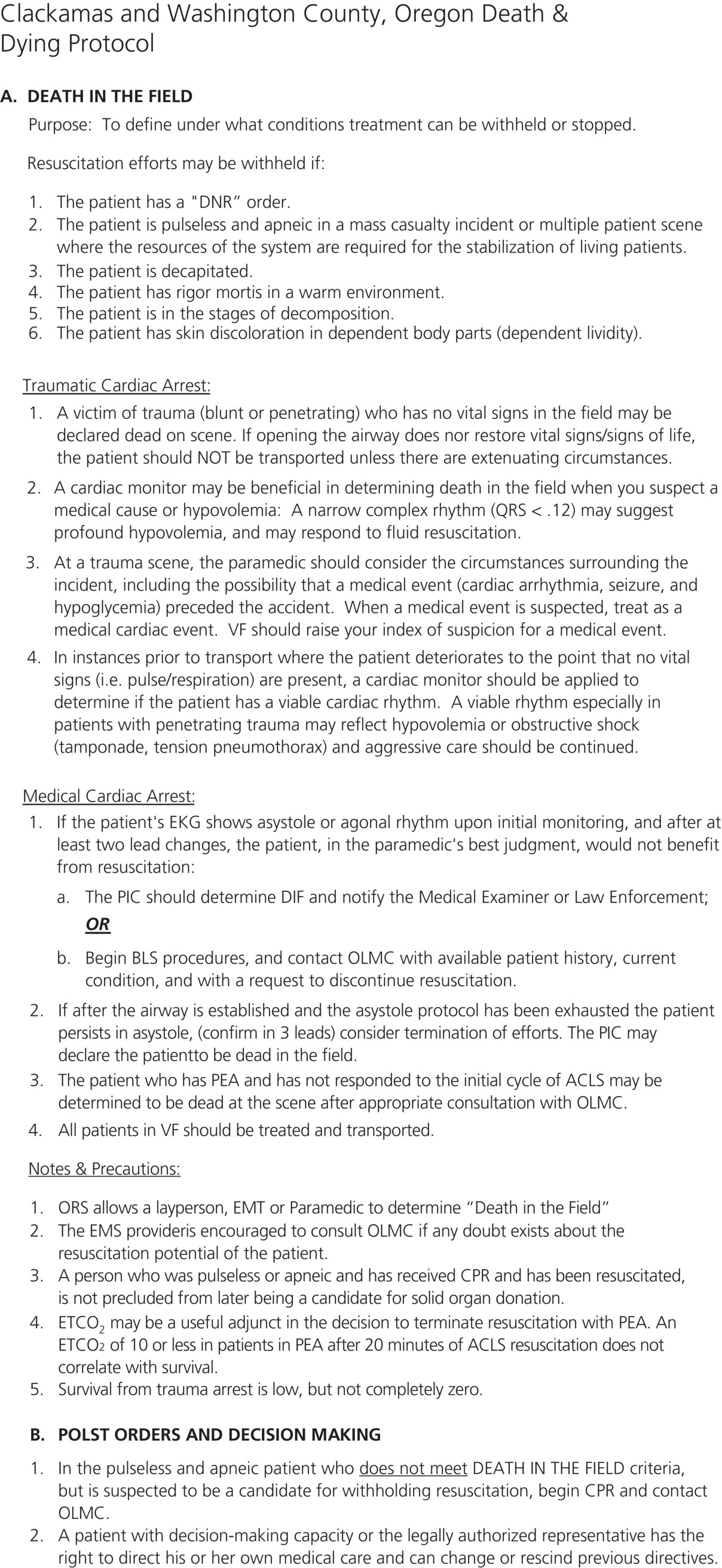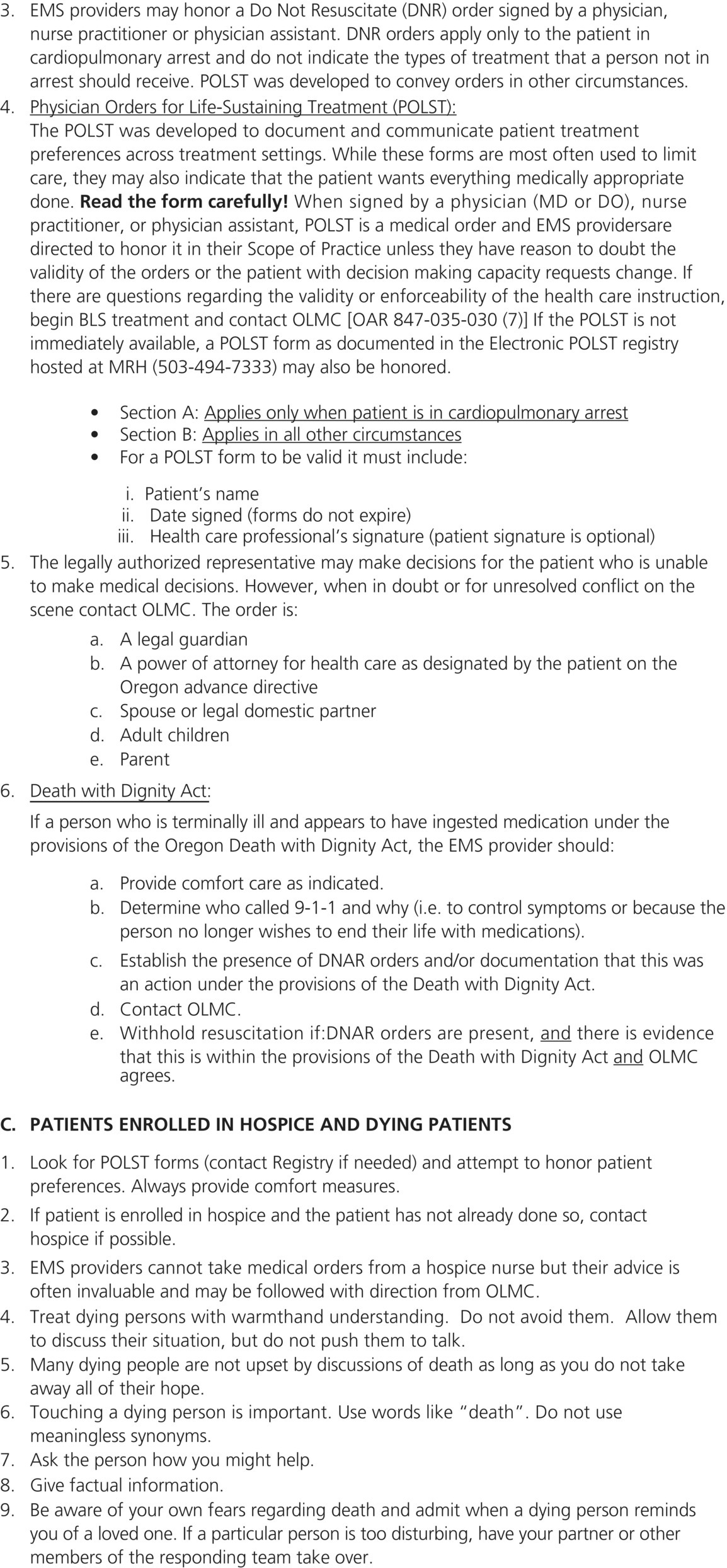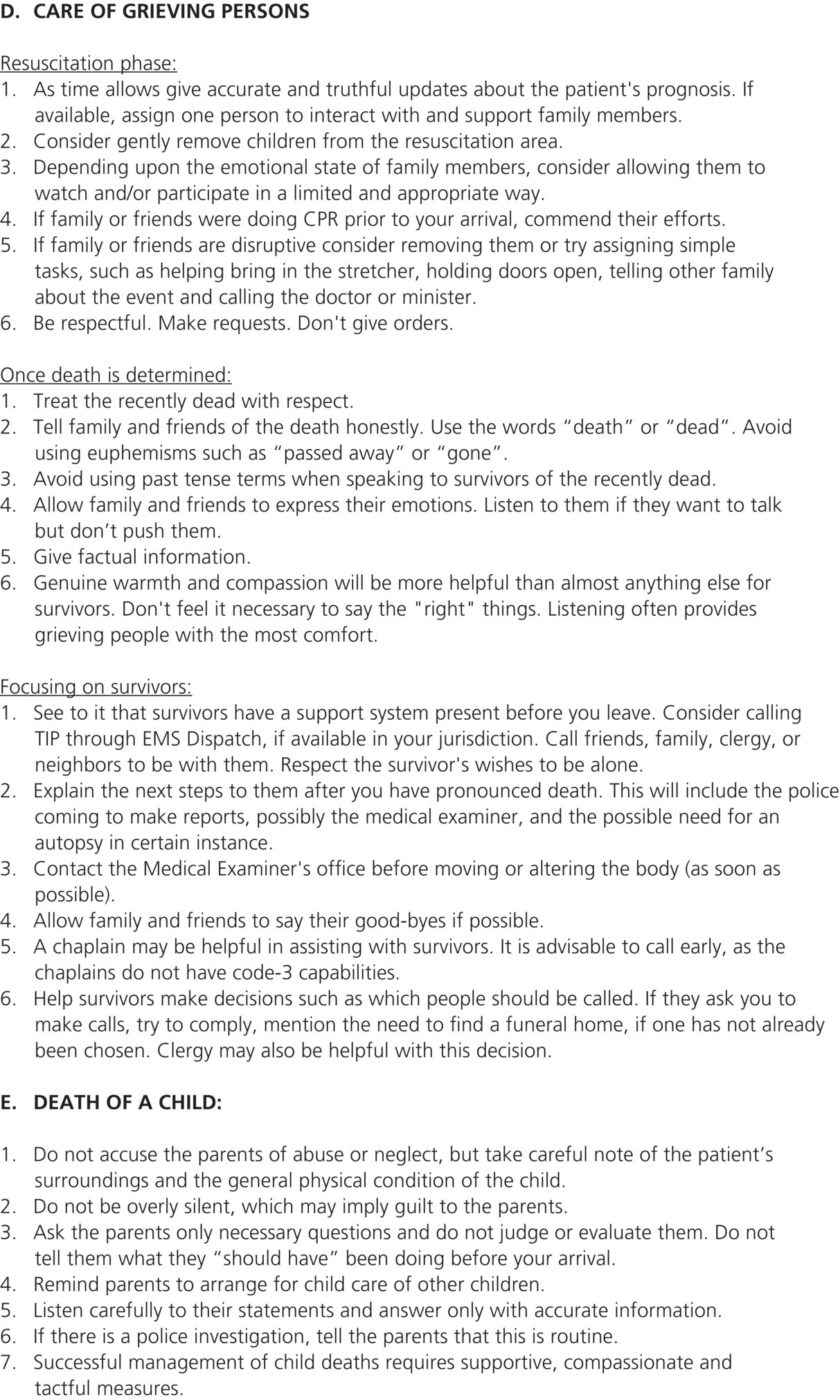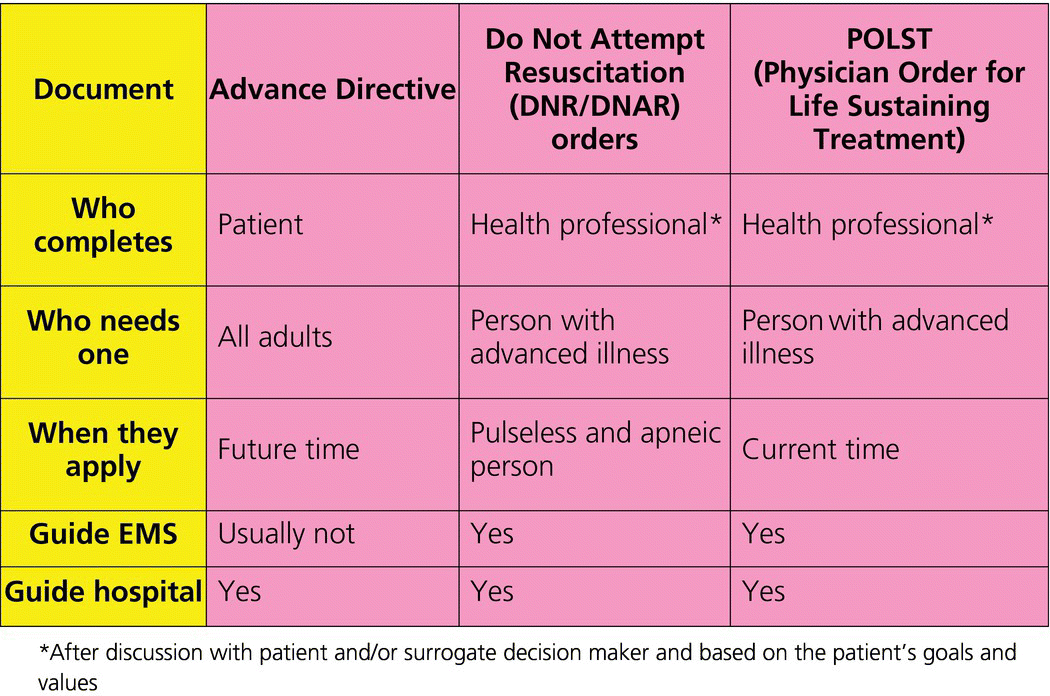Chapter 64 Aaron Case, Dana Zive, Jennifer Cook, and Terri A. Schmidt Memento Mori – Remember Death!*[1] The EMS system was designed to respond to emergencies to prevent disability and untimely death. With the aging of the population, EMS resources are now frequently called for patients with serious, life-threatening illness and for patients at or near the end of life. Many patients may not want the potentially life-extending interventions that are directed by standard EMS protocols [2]. A Canadian study found that nearly 10% of cardiac arrest calls were for patients with a terminal illness. In 63% of these cases, there was either a verbal (by family) or written request for no resuscitation [3]. Similarly, a Washington state study found that families of dying, terminally ill patients often called EMS because “they didn’t know what else to do.” Fewer than 10% of those patients had state-recognized formal written requests to withhold resuscitation, but a protocol allowing verbal and informally written requests to withhold resuscitation resulted in a significant decrease in unwanted interventions [4]. In addition, the American Heart Association reports that roughly 360,000 out-of-hospital cardiac arrests (OHCA) occur annually, with 60% treated by EMS professionals. The chance of survival from OHCA is generally poor [5]. Survival rates vary based on the presenting rhythm, with survival from ventricular fibrillation ranging from 11% to 25%,[6,7] and overall survival to hospital discharge for all presenting rhythms being much smaller, and in some systems approaching zero [8]. There is also evidence that patients who do not have return of spontaneous circulation in the field have a very low likelihood (0.4%) of survival to hospital discharge [9]. Thus, EMS professionals need to determine whether the OHCA patient desires resuscitation, and to compassionately interact with family in the aftermath of a death in the field. The EMS physician must design protocols to determine which patients should have attempts at cardiopulmonary resuscitation (CPR), or other life-sustaining interventions, and those who should not. (See Figure 64.1 for an example of one such protocol.) Considering the goals and ethical principles of medicine while remaining consistent with applicable local laws and regulations, these protocols should take into consideration patient preferences as well as the likelihood that the interventions will benefit the patient. It is not reasonable to assume that every patient found in cardiac arrest should undergo attempts at resuscitation, nor that everyone for whom resuscitation was attempted should be transported to the hospital. Figure 64.1 Example EMS palliative and end-of-life protocol. Source: Selected portions of Metro Regional EMS Consortium Patient Treatmen Protocols 2014. Reproduced with permission of Clackamas County Emergency Medical Services. The basic ethical principles on which modern medicine is founded include respect for patient autonomy, beneficence, non-maleficence, and justice [10]. Decisions about resuscitation are generally based either on the principle of respect for autonomy or on beneficence. Respect for patient autonomy requires honoring patient preferences for or against treatments, including advanced airway support, CPR, and transport to the hospital when those preferences are known. Based on both beneficence and non-maleficence, an intervention should not be performed if there is no chance that it will benefit the patient. The American College of Emergency Physicians’ position statement stipulates, “All emergency medical services (EMS) systems should have a policy addressing their response to ‘Do Not Attempt Resuscitation’ (DNAR) orders and other advance directives …” and “If the patient’s preferences regarding resuscitation are clear, they should be respected. Patient preferences to refuse resuscitative efforts can be communicated directly by the patient, or by an advance directive, a valid DNAR order, or by the patient’s legal representative. Unofficial documentation may be considered when determining patient preferences” [11]. The number of states authorizing out-of-hospital DNAR orders increased from 11 in 1992 [12] to 42 in 1999 [13]. As of 2002, most United States EMS systems did not have palliative care protocols [14]. In the last few years states have been implementing Physician Orders for Life-Sustaining Treatment (POLST) programs to document and honor patient preferences regarding both resuscitation and other life-sustaining treatments [15]. EMS agencies in King County, Washington, have developed protocols that allow EMS professionals to withhold resuscitation if the patient has a preexisting terminal condition and the patient, family, or caregivers indicates, in writing or verbally, that the patient did not want resuscitation [4]. This protocol allows EMS professionals to withhold resuscitation based on verbal information without physician consult. The authors interviewed involved EMS professionals and found that most report the decision to withhold to be easy, and that they do not receive objections or complaints about that decision. An advance directive is a written document, completed by the patient when he or she has decision-making capacity, expressing future wishes and/or appointing a surrogate decision maker. (See Figure 64.2 to compare documents indicating patient preferences). Advance directives have not been as effective as people had hoped [16]. The two main types of advance directives are living wills and durable powers of attorney for health care. Since 1991, the Patient Self-Determination Act has required all hospitals that accept Medicare and Medicaid funds to provide information about and develop policies for implementation of advance directives. Although there has been an increase in advance care planning since then, in many cases advance directives are still lacking when patients are transferred to emergency departments (EDs) [17–20]. One study found that many ED patients have never thought about advance directives or prefer that families make the decisions at the time of an event [21]. Figure 64.2 Comparison of advance directives, DNR/DNAR orders, and POLST. *After discussion with patient and/or surrogate decision maker and based on the patient’s goals and values. An expert panel has recommended that, “in the absence of signs of irreversible death, patient preferences regarding resuscitation should be the most important consideration of EMS personnel” [22]. EMS personnel need to make rapid decisions about attempting resuscitation for patients who are in extremis. Often the patients are unable to verbalize preferences about treatment and EMS professionals must make these time-critical decisions based on written instructions, when available. Unfortunately, written instructions are not always completed, or are unclear, which may be why systems such as King County now allow verbal statements. One type of advance directive, the living will, expresses the wishes of patients regarding life-sustaining procedures in the event of conditions such as permanent coma or terminal illness. Living wills are theoretical documents that may state, for example, that the person would not want resuscitation if he or she is terminally ill, death is imminent, and resuscitation would only prolong the dying process. Because of these restrictive phrases, living wills are often difficult for EMS professionals to apply to decisions about specific life support measures [23,24] and in many cases health care providers do not follow them [25]. In at least one state, these documents explicitly do not apply except in a hospital or clinic setting [26], and one author has suggested that they may be misinterpreted as applying when they do not [27]. Living wills are not precise enough to predict all scenarios and consequently cannot outline appropriate guidance for all potential care situations [28,29]. Another form of patient-completed advance directive is the durable power of attorney for health care, which gives another person the authority to make decisions if the patient is unable to make decisions either temporarily or permanently. The person designated in the power of attorney becomes a legally recognized proxy decision maker. When a durable power of attorney exists, EMS protocols may allow the designated person to make decisions regarding the patient’s medical care. Immunity is generally granted to providers who carry out the proxy’s decision in good faith, but it is always wise to know local laws. Some states allow surrogates without a specific health care power of attorney to make decisions about resuscitation and end-of-life care for incapacitated patients, and others do not. Appointing surrogates who are aware of the patient’s preferences can be effective, as long as the surrogate and the documentation confirming their status can be found at the time of an emergency. Unlike living wills and health care powers of attorney, DNAR orders are written by health care professionals to indicate that resuscitation should not be attempted in the patient who is pulseless and apneic. A national survey of EMTs found that 89% of respondents were willing to honor a state-approved DNAR order and that 77% of those surveyed had local protocols for termination of resuscitation in the out-of-hospital setting [30]. Although DNAR orders only apply when the patient is pulseless and apneic, many primary care providers, who complete the orders for their patients, believe that they apply in other circumstances and that intubation and cardioversion are not appropriate in a patient with DNAR orders [31]. There is variability in honoring DNAR orders. One EMS study found that even with DNAR orders present, resuscitation was attempted 21% of the time [32]. Some states have had success with their DNAR programs [33] but problems remain. For example, some states use a DNAR bracelet program requiring EMS professionals to honor these DNAR orders and providing immunity from liability for honoring the order [34]. However, one study suggests that bracelet DNAR programs are used infrequently [24]. In addition, advance directives and DNAR orders may not be available when EMS arrive and often do not accompany patients to the ED [18,35,36]. On the other hand, there are EMS systems that allow responders to accept verbal requests from family to withhold resuscitation.
End-of-life issues
Introduction



Advance directives

Do Not Resuscitate orders
Stay updated, free articles. Join our Telegram channel

Full access? Get Clinical Tree




